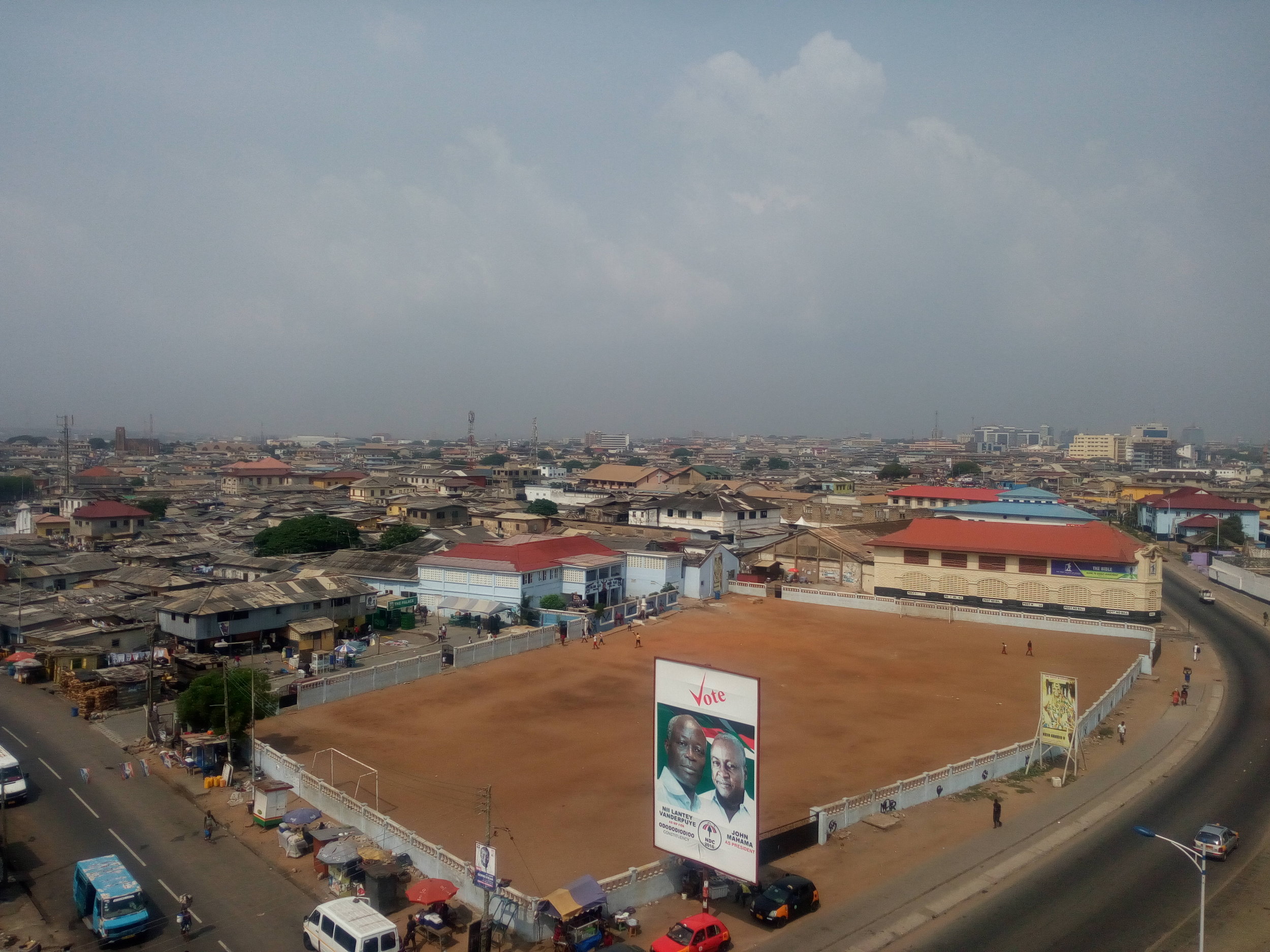By Eleanor Dunee
Aerial view of Jamestown, Accra
Ghana has a housing deficit estimated in excess of 1.7 million units. Yet, housing solutions proposed by governments over the years have either been unsustainable or too expensive. These solutions, especially those framed as affordable housing have often missed the intended target groups.
The target group of most public housing schemes is the working class, majority of who are in the low income bracket. This income bracket represents 60 - 70% of Ghanaians (GSS, 2005). The reasons given for the high deficit include the lack of a comprehensive housing policy, and high costs of construction. One reason often cited for the high construction cost is the high cost of building materials most of which are imported.
The Building and Road Research Institute (BRRI) in 2013 held a conference on housing at which various stakeholders and professionals in the building industry were invited to deliberate on the issue of housing in Ghana. Proceedings from this conference found that Ghana has a housing deficit of over one million housing units (BRRI, 2013). This figure is however disputed (BWG, 2012) with Ansah & Ametepey (2013) placing the figure at one million and five hundred units while the Minister of Water Resources, Works and Housing placed it at one million and seven hundred thousand (Andoh, 2014). Whatever the disparity in figures, it is generally agreed that there is a housing problem in Ghana (BWG, 2012).
A number of reasons have been given for Ghana’s high housing deficit. Prominent among these reasons is the high cost of construction materials. It is estimated that about 65% of the materials used in the construction industry are imported (BRRI, 2013). Honourable Sherry Ayittey, the 2013 Minister of Environment, Science and Technology, noted in BRRI (2013) that, over US$ 180 million is spent annually on importing clinker and gypsum for cement production. Other reasons given for the high housing deficit in Ghana include rural-urban drift, rapid urbanisation and rapid population growth all of which increase the unmet demand for housing.
Again, a lack of an effective and sustainable national housing delivery policy, high cost of decent accommodation and limited access to land are also stated as reasons for the high deficit (UN-Habitat, 2010; BWG, 2012; BRRI, 2013; Ansah & Ametepey, 2013). Having identified that Ghana has a housing deficit in excess of one million units, the question which may arise is: how is Government addressing this issue? Various governments have tried various approaches in addressing the challenge of housing. Governments’ interventions on housing would be looked at in two main periods; colonial and post-colonial era.
Colonial Era
The various interventions by government during this era were predominantly of the provider paradigm. Where support was given for self-help, the requirements and conditions surrounding access to such support made them inaccessible to those who really needed it. A few of these interventions by government are mentioned in the ensuing section.
The earliest recorded assistance by government is the Dispossessed Person’s Housing Scheme where natives of the then Gold Coast who had lost their houses as a result of the colonial government’s development programmes were compensated through an advance on loans for building materials (Agyemang,, 2001 cited in Ansah & Ametepey, 2013). Another intervention was the Accra Earthquake Victims’ Housing scheme which was meant to help the victims of an earthquake that occurred in 1939 in Accra. It involved the provision of affordable houses for those affected by the earthquake (Kwofie et al., 2011; Njoh, 2007).
Again in 1943, a four-year development plan was adopted to construct inexpensive ouses with locally available materials. This was followed by an affordable housing scheme in 1946 in which government provided financial assistance to people who wanted to build their own houses after the designs/plans for the houses were approved by the Town Council (Kwofie et al., 2011). This last intervention was along the lines of the supporter-oriented paradigm.
All these efforts during the colonial era at improving the housing situation did not solve the rising deficit. The schemes were mostly discontinued because they became very expensive especially where imported materials were used. This was because of the continually increasing cost of imported materials. Even in cases where local materials were used, the lack of a comprehensive policy to guide the schemes’ development made these efforts unsustainable.
Post-Colonial Era
The Government of Ghana between 1951 and 1956 established the State Housing Corporation (SHC) and the Tema Development Corporation (TDC). The SHC provided real estate for civil servants in all the regions of Ghana and also provided long term housing finance interventions. The TDC focused among others on the provision of affordable residential units for low income workers in the then newly established and rapidly growing industrial city of Tema (BOG, 2007; Kwofie, et al., 2011; Ansah & Ametepey, 2013).
The Schockbeton Housing Scheme was also introduced in the 1950s to produce houses using precast materials. It was presumed that prefabricated materials would be cheaper. The scheme however ended up being expensive and unsustainable due to high importation costs and was therefore abandoned. There was also a Roof Loans Scheme which was started in 1955 to assist public sector workers construct their houses. From 1959-1964, the Roof Loans Scheme was further expanded to not only give housing loans but also include service provision (Kwofie, et al., 2011; Ansah & Ametepey, 2013; Nelson & Ayeh, 2009 cited in Kwofie et al., 2011).
The Government of Ghana in 1977 again attempted to address the issue of housing by providing low-cost houses. This resulted in the construction of houses, the cost of which was so high that they could not be afforded by those they were intended for (GSS, 2005). Between the 1980s and 2010, there has not been any completed public housing scheme that was wholly provided by Government (Kwofie et al., 2011). The above mentioned schemes like the previous ones in the colonial era did not arrest the rising housing deficit. GSS (2005), points out that the demand for housing units in the 1970s had reached 70,000 units. Almost all the public housing schemes which start initially as low cost housing end up being too expensive for the original target group (low income bracket), that is, if they are completed. This is often because the amount initially budgeted for the scheme is exceeded due to inflation and high cost of building materials among others (Atiemo, 2009 cited in Kwofie et al., 2011).
The above mentioned schemes, like the previous ones in the colonial era did not arrest the rising housing deficit. GSS (2005), points out that the demand for housing units in the 1970s had reached 70,000 units. Almost all the public housing schemes which start initially as low cost housing end up being too expensive for the original target group (low income bracket), that is, if they are completed. This is often because the amount initially budgeted for the scheme is exceeded due to inflation and high cost of building materials among others (Atiemo, 2009 cited in Kwofie et al., 2011).
While formal interventions have been sought to provide housing, informal interventions are being taken by individuals to meet their need for shelter. The reasons mentioned seem to suggest that if the cost of building materials can be reduced then, the cost of the completed units would be reduced and would be affordable to Ghanaians in the low income bracket.

